Jet engine development, the Gloster Meteor and the V1 threat
RAF Manston yet again played its part in history when the jet engine age was born. In July 1944, the first operational jet squadron was initially based at Manston and was tasked with countering the V1 flying bomb threat to London.
First Jets
The first gas-turbine ‘jet’ engine was originally patented and built by John Barber of Nottingham in 1792. It was powered by wood, coal and other flammable substances, however the heat-resistant materials required to fully take advantage of the design were not available.
In 1921 and 1926, further work was carried out on turboprop engines, which still suffered from the same limitations.
By 1926, Frank Whittle, an apprentice in the RAF, had developed his own theory of using gas turbines to power aircraft at speeds and altitudes impossible for piston driven engines. Whittle knew that for man to fly faster, he would have to fly at a greater altitude where the air was thinner and that the conventional propeller would not be capable. At the same time, his mathematical talent was spotted and he was recommended for officer and pilot training. He patented his idea for a centrifugal compressor-driven turbojet engine in 1930. These papers were studied carefully by Dr Hans von Ohain in Germany who registered his own patent for a turbojet in 1936. On 27th August 1939 he developed a jet engine which flew for the first time in a Heinkel He 178 by Captain Erich Warstiz, but the flight was marked by the loss of the engine shortly after take-off by a bird-strike.
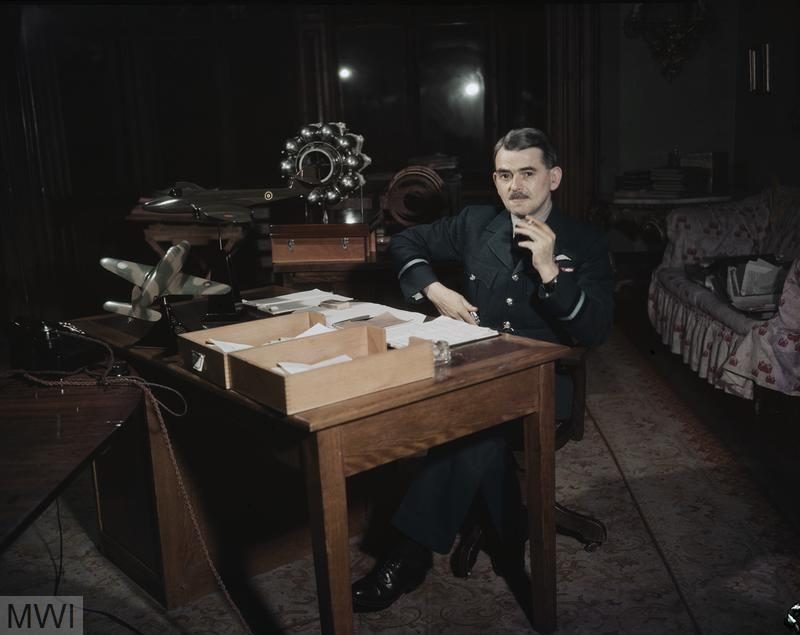
Note: This image has been altered to show correctly from that published by IWM.
Back in 1935, without the necessary money to renew his patent, Whittle was contacted by a fellow pilot, Rolf Williams and his business partner Collingwood Tinling to cover the cost of the patent and to setup manufacture of the engine. Power Jets Ltd was formed in March 1936.
The Gloster-Whittle E.28/39
With the threat of war, the Air Ministry contracted Power Jets to build a jet engine to power an experimental aircraft to be built by Gloster Aircraft Company, the E28/39 which would prove the jet engine concept. The single engined aircraft was flown by Gloster’s chief test pilot, Flight Lieutenant Philip “Gerry” Sayer on 15th May 1941 and powered by the Whittle W.1 engine.
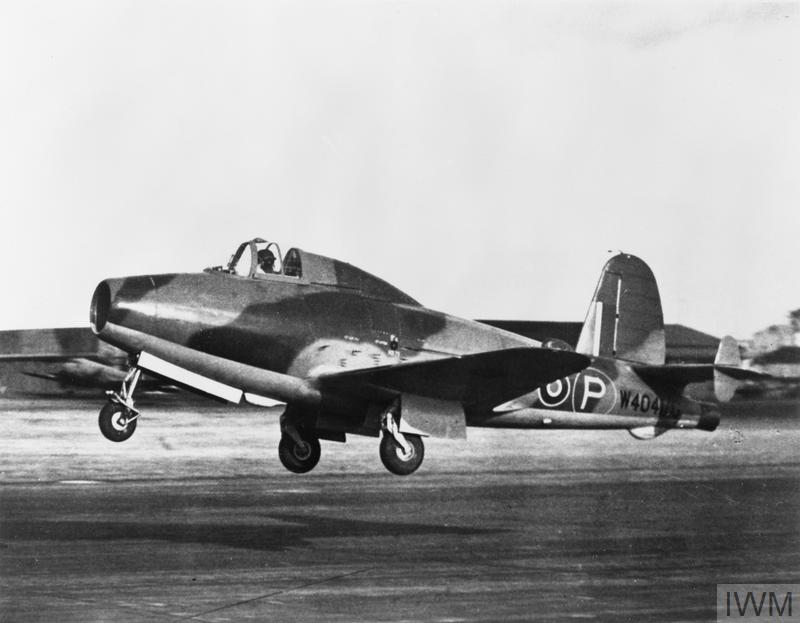
The limited thrust available from the early jet engines, would force subsequent aircraft to be powered by a pair of turbojet engines until they had developed further.
Film of the Gloster E 28/39 jet and Spitfire F 21 in an aircraft recognition study © IWM. Also available to watch here: https://www.iwm.org.uk/collections/item/object/1060021026
NOTE: The IWM had made what should be a second video above, available online, and to embed on this and other sites, but as we have experienced before, this was made unavailable as of 26/04/2020 and their new code to embed this video does not work even on 04/01/2023. You can watch the second video on the link above.
V1 Threat
The V1 flying bomb, also known as the doodlebug or ‘buzz bomb’ to many, was another project to be initially shunned by the Air Ministry, this time in Germany. Back in November 1939 the proposal for a remote-controlled aircraft carrying a payload of 1,000kg (2,200lb) over 310 miles was submitted, then refined in April 1940. By May, the Air Ministry cancelled the project sighting the difficulty of using the remote-control system in combat conditions.
Again, as with many developments, the designer, Fritz Gosslau, who had begun work on remote-controlled aircraft back in 1936, persisted with the idea and production was approved in June 1942.
The first V1s fell on London on 13th June 1944 and from then to March 1945, around 6,000 people would be killed and 40,000 injured throughout Europe. The most deadly V1 attack of the war in London occurred on June 18, 1944, when a V1 hit the Royal Military Chapel, Wellington Barracks, killing 58 civilians and 63 service personnel.
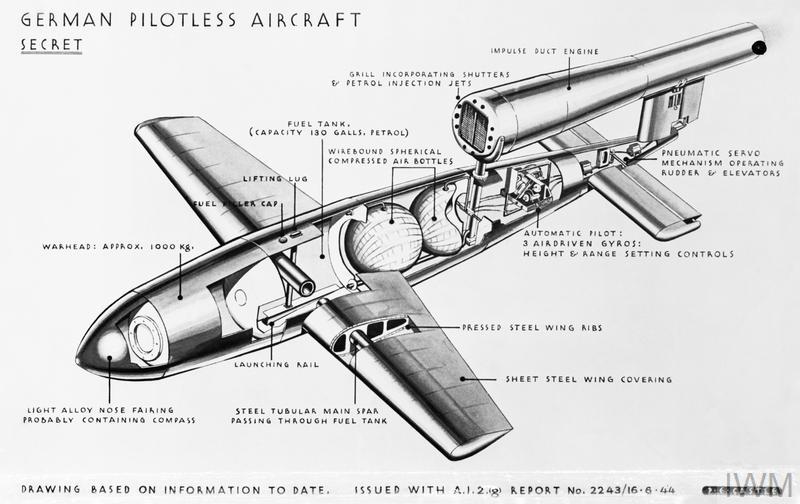
The V1s were able to reach a speed of more that 400mph, marginally faster that the best of the piston-engined fighters, even those that had been stripped of armour and paint, highly polished and powered by the highest octane fuel available. They were 8.32 metres long and had a range of 160 miles.
Meteor Prototypes
In August 1940, Gloster’s proposals for a twin-engined jet fighter led to an initial order of twelve prototypes (later reduced to eight) in February 1941. Initially to be called ‘Thunderbolt’, it was changed to Meteor to avoid confusion with the USAAF Republic P-47 Thunderbolt.
The first taxi runs had been carried out in the summer of 1942 by Gerry Sayer, and it seems clear that there were difficulties in the prototypes developments. Indeed the prototypes were fitted with an array of different engine types and configurations.
After Gerry Sayer was killed whilst testing a Hawker Typhoon, Michael Daunt took over the flying programme. The first Meteor to fly was DG206/G on 5th March 1943 when it took to the air for just three minutes and thirty seconds, piloted by Michael Daunt at RAF Cranwell. It was powered by de Havilland Halford H.1 engines, substituted in due to problems with the intended ‘Whittle’ Power Jets W.2 engines. On this first flight there was an uncontrollable yawing motion which led to a redesigned larger rudder.
Prototype DG205/G was the first Meteor flown to be powered by ‘Whittle built’ Rover-built Power Jets W2.B (Welland) engines on 12th June 1943 followed by DG202/G on 24th July 1943. There would be a total of eight prototypes (DG202 to DG209).
| Prototype | Engines | First Flown | Notes |
| DG202 | Power Jets W.2B/23 (Welland) | 24/07/1943 | Later used for deck handling tests aboard aircraft carrier HMS Pretoria Castle. |
| DG203 | Power Jets W.2/500 | 09/11/1943 | Later became a ground instructional airframe. |
| DG204 | Metropolitan-Vickers F.2 | 13/11/1943 | During a subsequent flight on 4th January 1944, the compressor failed. The pilot, Sqn Ldr William D.B.S Davie abandoned the aircraft over Farnborough but was killed. |
| DG205 | Power Jets W.2B/23 | 12/06/1943 | The first “Whittle Powered” Meteor, used by Gloster for handling trials. Lost in a crash 27th April 1944, killing Gloster pilot J.A. Crosby-Warren. |
| DG206 | de Havilland Halford H.1 | 05/03/1943 | The first Meteor to fly. |
| DG207 | de Havilland Halford H.1 | 24/07/1945 | Was intended to be the basis for the Meteor F.2 with de Havilland engines, but by the time it flew, the Meteor 3 was in full production and de Havilland’s attention was being redirected to the incoming de Havilland Vampire, thus the F.2 was cancelled. |
| DG208 | Power Jets W.2B/23 | 20/01/1944 | By this prototype, the majority of design problems had been overcome and a production design had been approved. |
| DG209 | Power Jets W.2B/37 | 18/04/1944 | Used as an engine testbed by Rolls-Royce. |
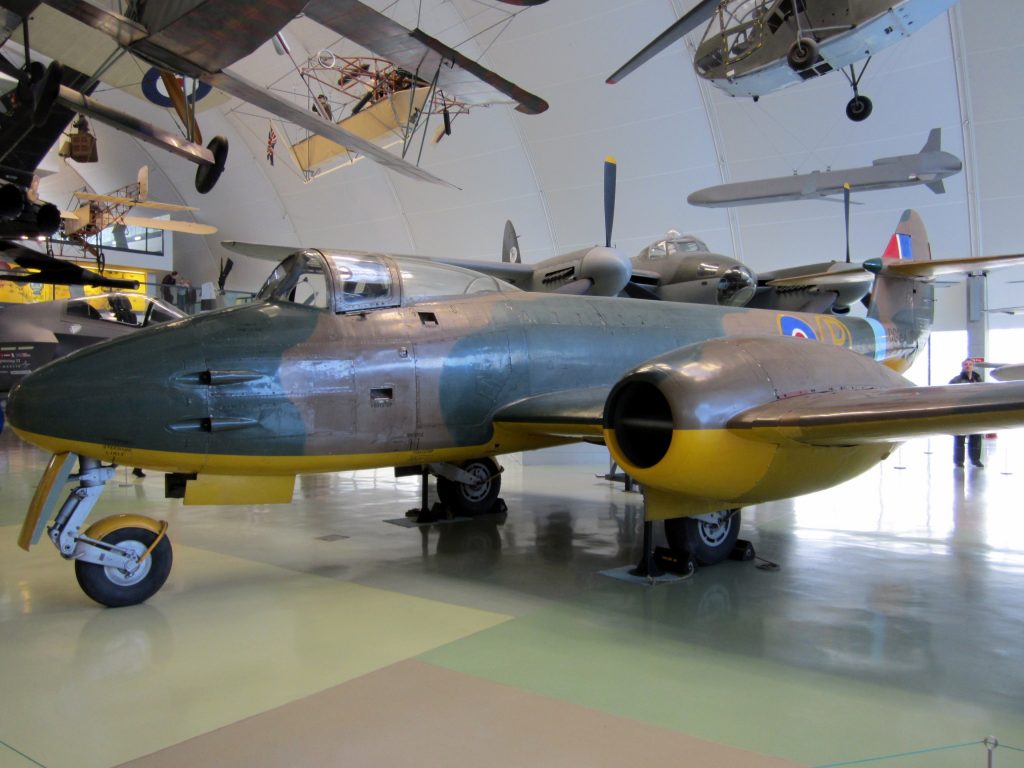
In August 1941, a contract was placed for 300 Meteors, split between 200 F.Is (Mark Is) and 100 F.IIs (Mark IIs). Later the F.II version was cancelled so the order reverted to all F.Is. However it was eventually delivered as twenty F.Is (EE210 to EE229) between February and September 1944 and 230 F.IIIs (Mark IIIs) of which 111 were delivered before VJ Day on 2nd September 1945.
Further orders were placed in August 1943 for 100 F.IIs, eventually delivered as F.4s after the war, and in an order in February 1945 for 300 F.IIIs, but these would be cancelled following the end of the war in September 1945.
Operational Use at Manston
12th July 1944 – During the afternoon, two Meteors (EE213 and EE214) arrived from Farnborough to No.616 (South Yorkshire) Squadron based at Culmhead. These two were not fully operational and were used for training purposes. Although both aroused much interest, they were closely guarded.
Some accounts say that the first aircraft to arrive at Culmhead was EE215 followed a day later by EE216 and EE217, however our timeline currently references arrivals as detailed in 616 Sqn records.
21st July 1944 – The first two Meteors (EE213 and EE214) were transferred to RAF Manston, as officially did the Squadron, still operating Spitfires. The Squadron had a busy morning packing before taking off from Culmhead at 1155hrs. The Meteor and Spitfire pilots were billeted in separate huts and the Meteors kept under cover and under guard in the hanger. The Meteors would be used to counter the threat of the V1s targeting London, where at the time, only the Hawker Tempest had the low-altitude speed to be effective against them, but fewer than 30 were available.
Although limited in numbers and in their range, the 410mph Meteor was marginally faster that the Tempest V and Spitfire XIV with top speeds of 405mph and 396mph respectively, but it excelled at 1,000 to 3,000 feet, just where the V1 operated.
22nd July 1944 – W/Cdr McDowell put on a display in a Meteor for the visit of Harold Balfour M.C. M.P., Parliamentary Under-Secretary of State for Air. The first Meteor flight consisted of: W/Cdr McDowall DFM & Bar; W/Cdr Wilson AFC; S/Ldr ‘Watty’ Watts DFC; F/O Rodger; F/O McKenzie RCAF; P/O Clerc; F/O ‘Dixie’ Dean and W/O Wilkes.
23rd July 1944 – five more Meteors F.1s (EE215, EE216, EE217, EE218 and EE219) arrived at Manston from Farnborough. The ground crews had another busy day and F/L Watts arrived as Squadron Engineer Officer.
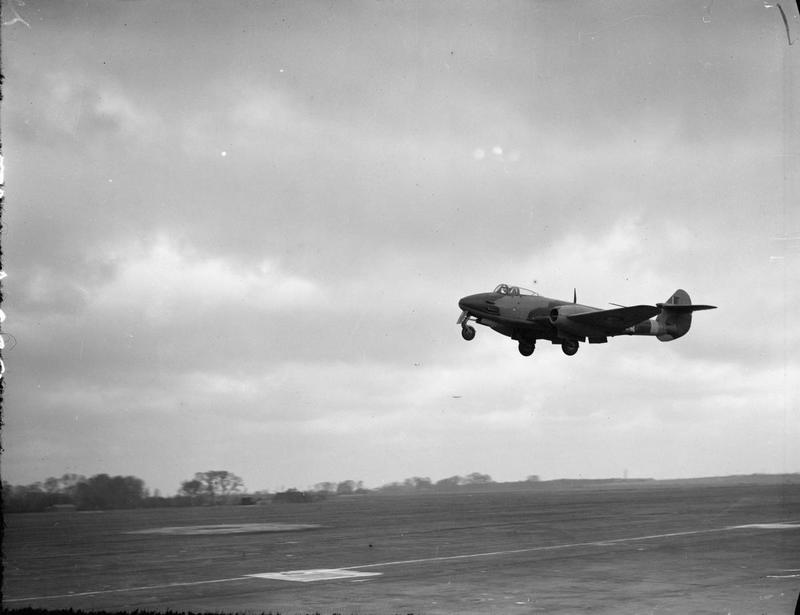
26th July 1944 – ‘Meteor Flight’ was declared operational and the squadron was keen to start operations against the V1. The squadron was the world’s first operational jet squadron before the debut in August of the rocket powered Messerschmitt Me 163 Komet, and in October, the Messerschmitt Me 262, although there was a report of the first encounter of the Me 262 on 25th July on an experimental interception against an RAF Mosquito.
27th July – at 1430hrs F/O Bill McKenzie RCAF took off to patrol a line between Ashford and Robertsbridge where the V1s were often encountered. It was the first operational sortie by an RAF Gloster Meteor Jet Fighter. In the Squadron log, it announced ‘History is made!’. The anti-diver patrol (after the way the V1 rockets flamed out then dropped from the sky) was uneventful. Five other patrols were carried out that day by the Flight.
S/L Watts was close to opening the Meteor’s score against the V1, but his cannons jammed after two rounds, while F/O Dean was able to close to 1,000 yards of a V1 flying at 390mph, with his aircraft flying at 405mph, but was turned back by Control because of the danger of nearby barrage balloons. After the same problem the next day to another pilot, it was found that the cause was updraught in the cartridge case ejection slots under the fuselage. The pilots were convinced that given favourable weather, the Meteor would be able to knock down the V1s.
W/Cdr McDowall, W/Cdr Wilson, F/O Rodger and W/Cdr Wilkes were all also on patrol on this day, but theirs were uneventful.
28th July – Patrols were maintained, with each patrol being approximately 40-45 minutes long but no kills recorded. Two more Meteors arrived in the evening, flown in by F/O McKenzie and W/Cdr Wilkes.
29th July – Wing Commander Wilson, flying on an engine test, sighted a Diver at 3,000 feet near Rye travelling at 360mph. He opened fire but was out of range and lost it in cloud. P/O Clerc sighted 3 Divers at heights between 2,000 to 4,000 feet but was unable to engage because of a Mustang attempting to shoot them down at an extreme range.
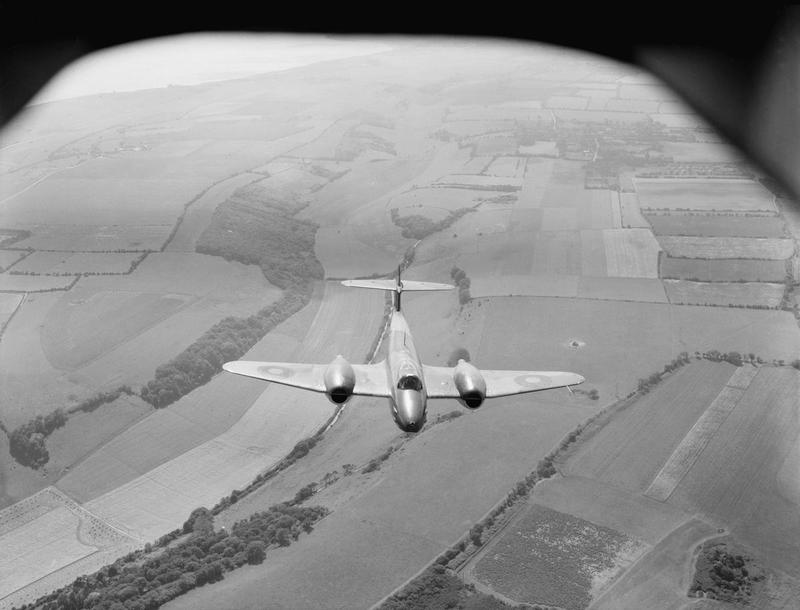
30th July – Two scrambles. F/O Dean chased two V1s and fires at one with unobserved results because of cloud. All the Squadron was by then waiting to record the first Diver kill. A visit was made by Sir Roderick Hill A.D.G.B.
31st July – Low cloud and poor visibility led to only local flying and cannon testing.
1st August – The poor weather continued, so again only a little local flying. F/L Thomas joined the Squadron as Armament Officer.
2nd August – At this point, the Meteor Flight consisted of six operational aircraft and the two prototypes. Again there was little operational flying. W/O George made a local flight. S/Ldr Watts, F/O Dean, F/O McKenzie and F/O Clerc all made uneventful patrols between Ashford and Robertsbridge of around 45 minutes. The weather was still cloudy and the Meteors continued to attract a lot of attention and visitors. In the evening, a visit was made by Group Capt. Fleming A.D.G.B.
3rd August – The weather had improved and at 0930 hrs, the Anti-Diver patrols commenced. Flt Lt Mike Graves sighted a Diver in the Ashford/Robertsbridge area at 2,000 feet. With throttles set forward, he was able to close the gap between himself and the rocket and fired a two second burst from 400/500 yards but there was no evidence of any damage. His 20mm cannon had been firing 100 rounds of high explosive/incendiary and semi-armour piercing shells, by he was too far behind. As he was manoeuvring for a second attack, a Mustang sent the V1 crashing to the ground with a short burst of 0.50in shells from its six wing-mounted guns. Graves was emphatic that a Mustang attacking at the same time stopped him getting his first kill. By the afternoon the weather was warm and sunny. The flying bombs were again seen and heard passing over Manston at night. The Squadron were happily settled in new quarters at Hurlingham Lodge in Westgate.
4th August – Another Key Event at Manston! First V1 flying bomb downed by a Gloster Meteor Jet. In the morning, haze and poor visibility prevented operational flying. F/O Dean took off from Manston at 1545hrs in Meteor EE216 to patrol inland area under Kingsley II (Biggin Hill) Control. At 1616hrs, a Diver was sighted at 1,000 feet near Tonbridge. Dean dived down from 4,500 feet at speed of 450 mph and attacked it from dead astern. His four 20mm cannons failed to fire, a common failing for the Meteors, so instead, flying level alongside the bomb, Dean manoeuvred his wing tip a few inches under the wing of the flying bomb and by pulled upwards. It send the bomb diving to earth four miles South of Tonbridge. F/O Dean would be reprimanded for damaging the wingtip of his aircraft. Later ‘tipping’ would change from a physical tip to positioning the aircraft’s wing above the wing of the bomb, disrupting the airflow and thus affecting the gyroscope from which the V1 would crash.
F/O J.K.Rodger sighted a Diver at 1640 hrs, near Tenterden on course of 318° at 3,000 ft and a speed of 340 mph. Attacking from astern, Rodger fired 2 bursts of 2 seconds and saw the Diver crash and explode, 5 miles N.W. of Tenterden, claiming the Squadron’s second kill.
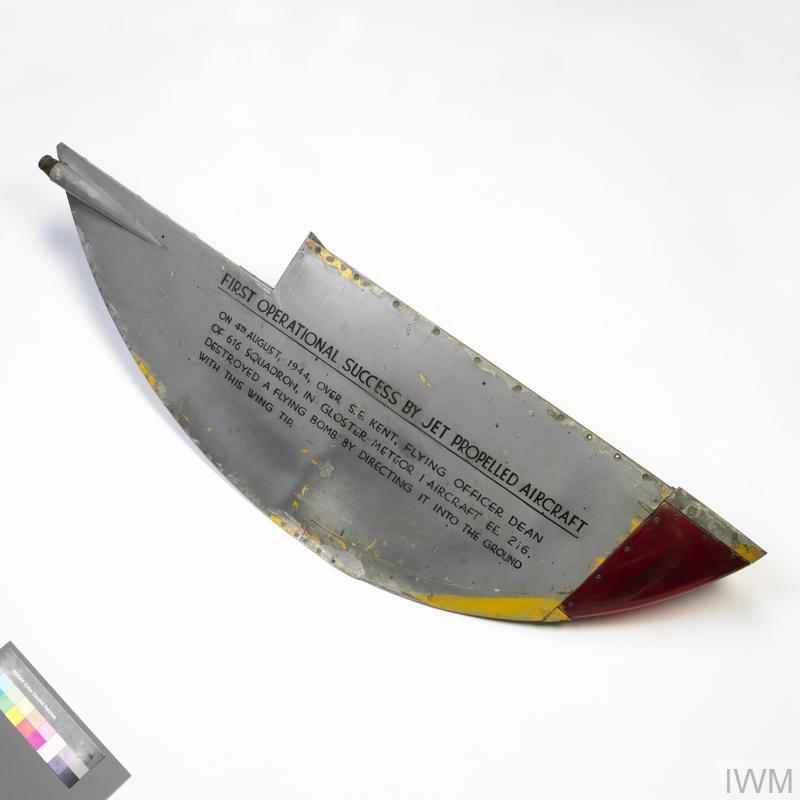
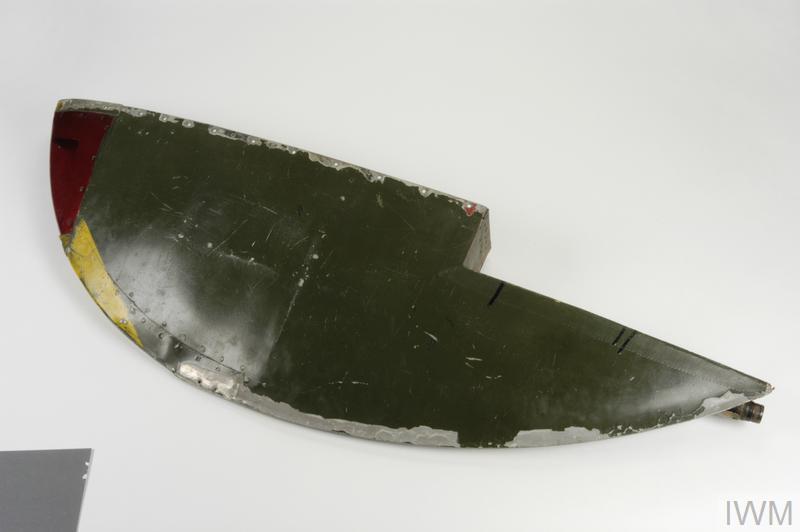
5th August – The day consisted of five uneventful scrambles and two patrols, but there was nothing of interest to report. Two more Meteors were delivered, bringing the Squadron to 10 operational and 2 prototypes.
6th August – Two aircraft were scrambled after midday, following another morning of low cloud and mist. No Divers were reported in the afternoon. In the evening, two aircraft were scrambled, but there was nothing to report.
7th August – From first light at 0555hrs to 1345hrs, six aircraft were scrambled. F/O ‘Dixie’ Dean got another V1 near Horsham at 0620hrs at 1,000 feet, using all his ammunition on it.
At 1300hrs, the Rt. Hon Sir Archibald Sinclair Bt. F.C., C.M.G., M.P., Secretary of State for Air arrived at the Station. He was greeted by W/Cdr McDowall DFM and introduced to the pilots, from whom he was interested to heard first hand news. During the visit F/O Rodger and F/O McKenzie were scrambled, allowing them the ability to show off the Meteors.
8th August – No operational flying, but W/Cdr Wilson and F/Sgt Epps made local and air firing tests.
9th August – Eight aircraft scrambled and three aircraft were on Anti-Diver patrol, but all were uneventful. During the afternoon the CO flew to High Halden, near to Ashford to assess the possibilities of using it as a forward base for Anti-Diver patrols. The Squadron was split into an “A” and “B” flight, both of 16 pilots, under the command of W/Cdr McDowall.
10th August – From first light there were six routine patrols and twelve pilots scrambled. F/O Dean got another V1 near Ashford using two short bursts from his cannons. F/Lt Thomas (Armament) left, with the Squadron Armoury taken over by P/O Jordan.
11th August – Four aircraft were scrambled but all were uneventful.
12th August – No operational flying, but some local. Another visit by Air Marshal Sir Roderick Hill A.D.G.B.
13th August – W/Cdr Wilson took a Meteor up for an air test and made an uneventful Anti-Diver patrol at the same time. Three local flights were made and W/Cdr McDowall took off for a weather test.
14th August – Uneventful anti-Diver patrols. Four aircraft were scrambled from Manston and two from High Halden, plus two routine patrols from High Halden.
15th August – The remaining Spitfire VII’s of the Squadron were finally allotted away. Two patrols were launched from Manston at 0615hrs and four from High Halden, plus two scrambles from there. During the evening, the first fatal accident would occur in a Meteor. F/Sgt D.A. Gregg took off from Manston to fly to High Halden, to take up his readiness duty, but unable to find the landing ground, he attempted to land at Great Chart Airfield and whilst doing so crashed.
16th August – F/O McKenzie shot the wing off a V1 and F/O Mullender claimed another.
Consolidated Diver Report
616 Squadron, ManstonF/O W. McKenzie, R.C.A.F. 16 August 1944
After an uneventful scramble, F/O McKenzie was about to land at Manston when Control (Kingsley 11) passed information that Divers were coming in. F/O McKenzie was sent back to orbit approximately 5 miles S.E. Ashford at 3000 ft. One Diver was seen flying on a course of 320 degrees at 1000 ft, at speed of approximately 360 mph. F/O McKenzie positioned to 700 yards behind and 500 ft below Diver at approximately 0938 hrs. A Mustang was seen to attack from line astern and fire from 250 yards. No strikes were observed and the Diver continued on a straight and level course. The Mustang then pulled upwards and broke away. Immediately F/O McKenzie attacked from astern at range of 400 yards and fired a 4 second burst. Strikes were seen all over Diver and starboard wing fell off. Diver then rolled over on its back and went down to explode on ground approximately 6 miles southeast of Maidstone at approximately 0940 hours. This position and time has now been confirmed by Royal Observer Corps at Maidstone.
CLAIM: 1 Diver destroyed by F/O W. McKenzie (R.C.A.F.)
SQUADRON: 616 Squadron AIRCRAFT: Meteor Mk I
CALL SIGN: Hugo 19 WEATHER: Hazy, visibility 5 miles
TIME UP: 0910
TIME DOWN: 0950
On the same day there are eye-witness accounts that a V1 that had been shot down and crashed into the railway line at Oak Lane, between Rainham and Newington, seemingly hitting the railway bridge that takes the lines over the road. The witness suggests it was a Spitfire that caused the V1 to crash and the loss of life caused. The explosion destroyed the bridge, with the train half way over it. Such was the danger in trying to prevent the V1s reaching London.
17th August – F/O Ritch, W/O Woodacre and F/Sgt Easy each claimed a V1. It would also see the wounding of Cpl W.M. Harding who died eight days later. F/O McKenzie inadvertently fired Meter EE225’s cannons whilst waiting at dispersal, possibly at High Halden. He wounded a total of four groundcrew and W/Cdr Wilson’s EE224. Although McKenzie was found negligent, W/Cdr McDowall insisted it was an accident down to aircraft malfunction.
19th August – F/O Hobson and F/Sgt Watts each claimed a V1. F/O Hobson also claimed a share of another. F/Sgt Cartmal saw his strikes on another, but was unable to see the end of the Diver when his gun sight bulb failed.
28th August – F/O Hobson and F/Sgt Epps shared a V1 kill near Ashford. That brought the Squadron total to 12½ Divers destroyed.
29th August – F/O Hugh Miller destroyed a V1 at 1415hrs, south west of Sittingbourne, which was to be his first and No.616 Squadron’s last V1.
I intercepted a Diver just north of Ashford. Two Tempests were seen 600 yards behind it. Both fired but no strikes were observed. Owing to the Tempests flying line astern of the Diver, I was forced to make a beam attack from port. I fired three two-second bursts at 100 yards. Strikes were seen on the port wing. I again attacked , this time from above and slightly behind at 400 yards. By this time, the two Tempests, still line astern, appeared to close in on the Diver. I observed strikes from my fire and the Diver rolled over and exploded when it hit the ground four miles south west of Sittingbourne.
No.616 Sqn Meteor FI EE222/G YQ-G piloted by Wing Commander Andrew McDowall DFM crashed three miles south of Manston in a field near Plucks Gutter, Stourmouth after running out of fuel and losing both engines. The pilot was injured with a few cuts, but the aircraft was damaged beyond repair and was struck off charge.
By the end of August 1944 the V1 sites in France were overrun by Allied ground forces, reducing the attacks on London. Thirteen V1s were confirmed killed by the squadron by the time the launches stopped.
8th September – First V2 launched against London, landing in Staveley Road, Chiswick, killing three and badly injuring 19. The V2 was the world’s first long-range guided ballistic missile. Flying at a maximum of 3,580 mph, there would not be an opportunity for fighters to intercept the 14 metre long V2, so attention instead focused on unsuccessful attempts to jam what was thought was its radio guidance system, and bombing missions, both as part of Operation Crossbow. The V2 had an operational range of 200 miles.
10th October – Five pilots and four Meteors move to Debden as part of a training exercise so bombers and escorts can determine tactics to counter jet aircraft. During the next few days there, there was an exercise involving 140 B24s and 40 Mustangs and Thunderbolts against the four Meteors on the 11th and 12th October, then practice dogfights between three Meteors and 20 fighters on the 15th October.
26th October – There was an exercise involving a Lancaster bomber formation being escorted by Spitfires whilst being ‘attacked’ by Meteors. It would appear the Lancasters proved to be easy targets and the Spitfires ‘offered no serious opposition’. It would seem that there was starting to be a shift of power towards jet aircraft.
18th December – The first delivery of Meteor F.IIIs (Mark IIIs) arrive, flown in by W/Cdr McDowall and F/Sgt R.C.H. Easy. The F.III had improved performance over the F.I and also made the F.III superior over the contemporary Sptifires and Mustangs in speed at least. The F.III would still suffer as the F.I did, with slow response to the throttle. Top speed would be 486mph at sea level and 493mph at 30,000 feet. It would become the RAF’s standard jet fighter until replaced by the F.4 (Mark 4) from 1947 (which would see an increase in speed again to 583mph at sea level and 570mph at 30,000 feet, plus with dramatically improved acceleration).
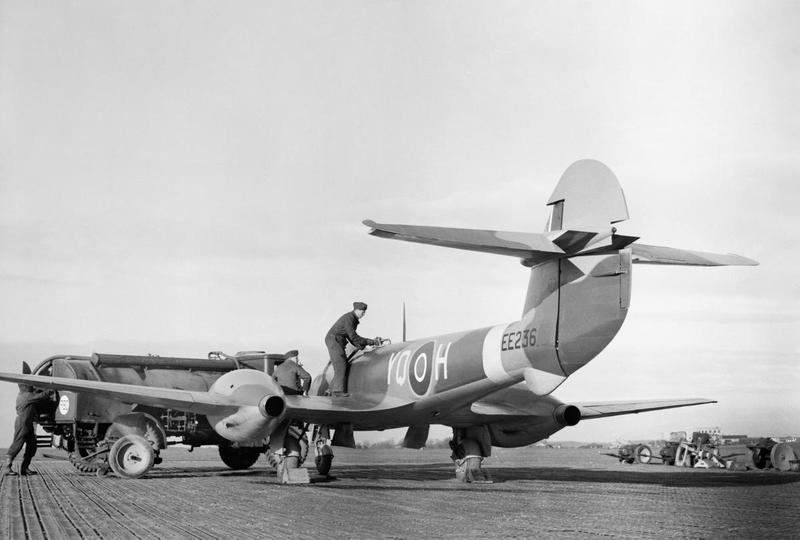
24th December – Four pilots flew in to Moreton Vallance in an Airspeed Oxford, returning later with another 3 Meteor F.IIIs.
25th December – A soccer match was played between pilots and ground crew at Westgate (the ground crew won) then Officers and NCOs serve Christmas dinner in the Airmen’s Mess. The Squadron’s Christmas party was held in Margate in the evening.
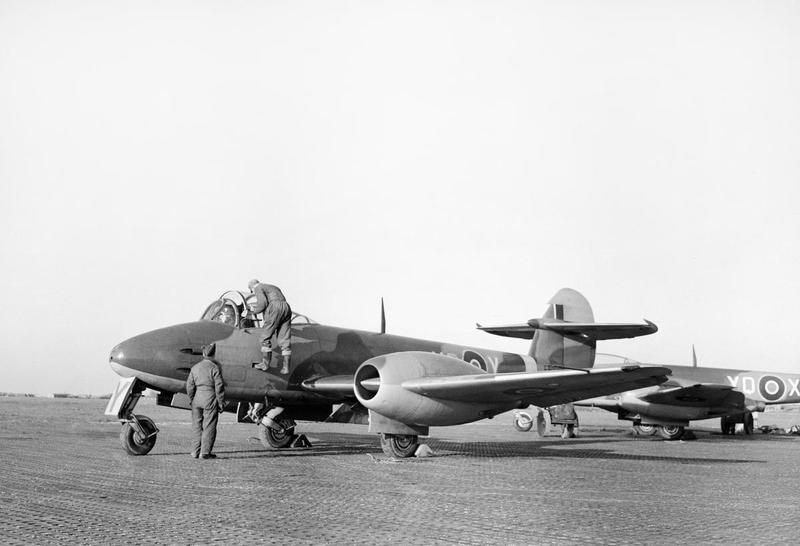
16th January 1945 – The Squadron had a very busy day packing up for its move.
17th January – No.616 Squadron was transferred to Colerne.
The final V2 would land in Court Road, Orpington, on 27th March 1945, claiming one life. The last V1 landed at Swanscombe the next day.
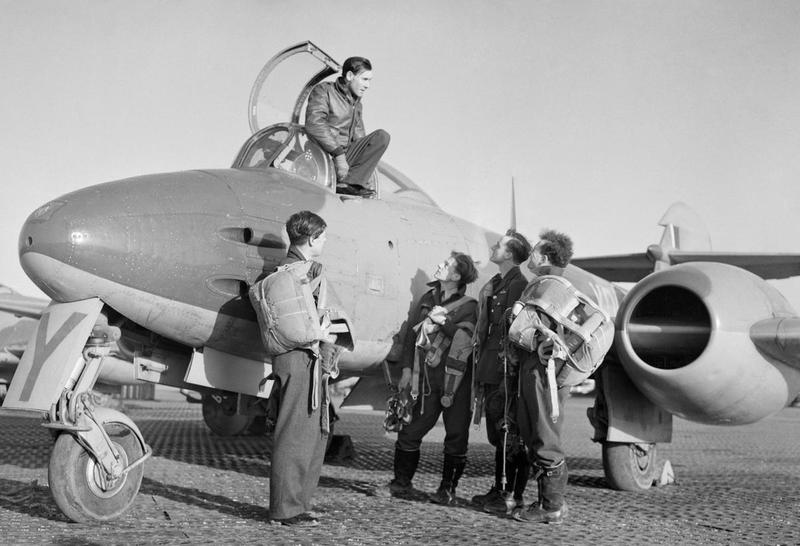

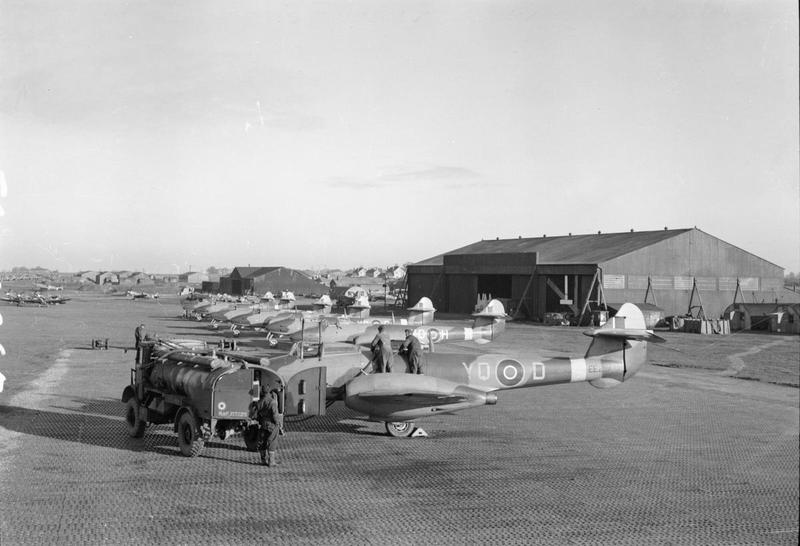
The short period of battle between the Meteor and the V1 would prove to be a reasonable success for the British jet, but it accounted for just 14 V1 kills by the end of the war. Even so, the jet that was rushed into service with unreliable armament and slow acceleration. The numbers available were dwarfed by the numbers of other aircraft available to defend – over 100 Hawker Tempests by September 1944 which accounted for 638 flying bombs. Sqn/Ldr Joseph Berry of No.501 Squadron would account for 59 and W/Cdr Roland Beamont (also known at Manston during his time with No.609 Squadron) would destroy 31. Other aircraft used included Mosquitos, Spitfire XIV and Mustangs.
However, the age of the jet had begun.
Footnote
Gloster Meteor EE227 would be handed back to the Rolls-Royce facility in Hucknall in February 1945 as a flying test bed for the newly developed RB.50 Trent propeller-turbine, or turboprop as we know them today. It combined the proven capabilities of a propeller with the high power and lack of vibration of the turbine engine. Its maiden flight was on 20th September 1945, but would end its days, lost, as so many other pioneering aircraft have, in fire destruction tests at Farnborough.
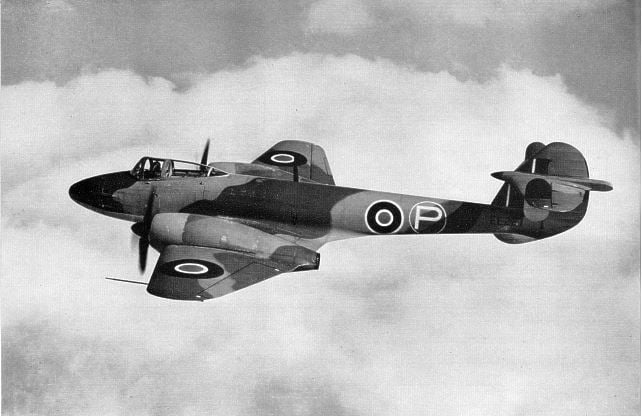
More information:
See a display of the V1 flying bomb outside the RAF Manston History Museum.
References:
No. 616 Sqn ORB (records)
Britain’s Jet Age: From the Meteor to the Sea Vixen, by Guy Ellis.
The Gloster Meteor F.I & F.III, by Phil H Listemann.
Gloster Meteor, by Phil Butler and Tony Buttler.
Britain’s Greatest Aircraft, by Robert Jackson.
V1 Flying Bomb Aces, by Andrew Thomas.
Meteor I vs V1 Flying Bomb: 1944, by Donald Nijboer.
http://www.redtwo.plus.com/616/jets.htm (although some dates appear incorrect)
Artwork:
‘Meteor strikes its first blow’ by Frank Wootton. Depicts Meteor EE216 flown by F/O Dean on 4th August 1944.
‘Meteoric Victory’ by Tom Marchant. Depicts Meteor EE218 flown by Warrant Officer Sid Woodacre over Kent, August 1944.
First published: 21st July 2017.
Last Updated: .


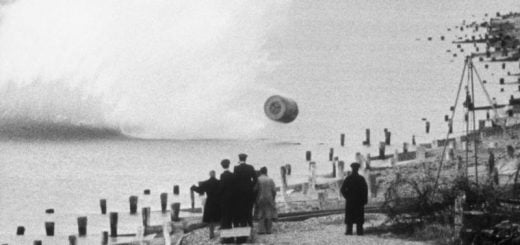
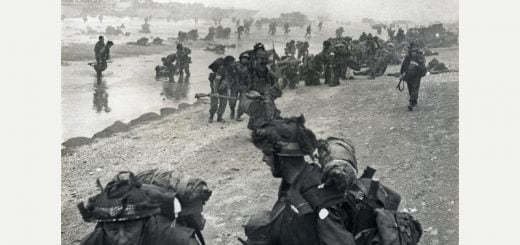
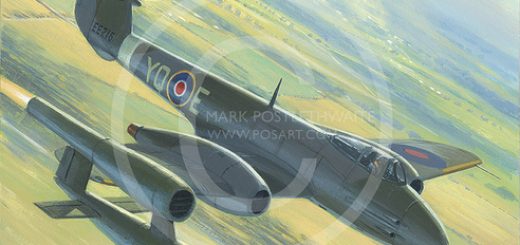




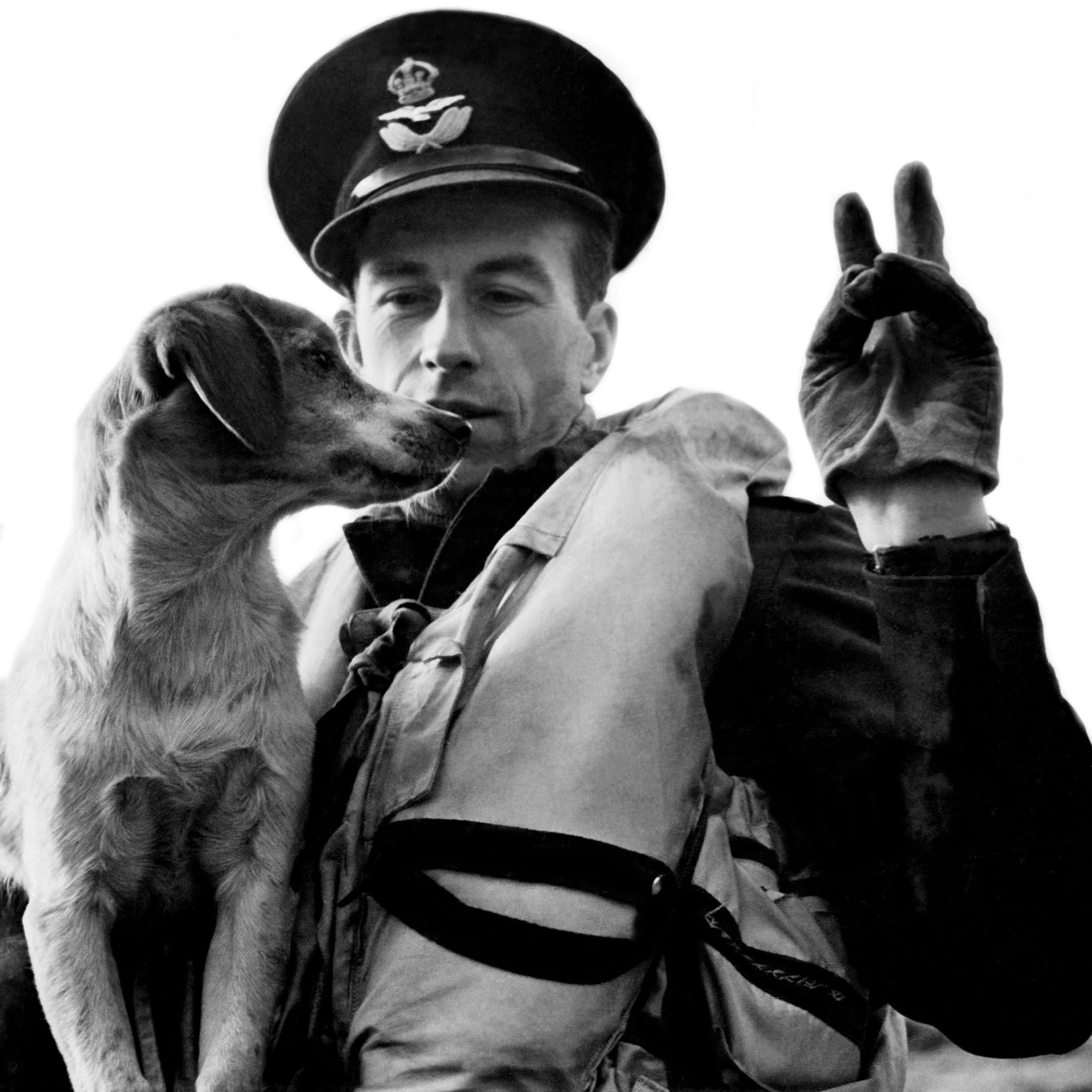
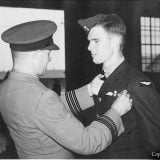


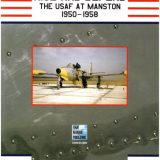
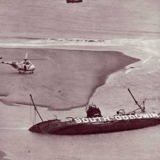
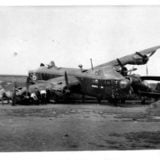
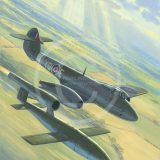
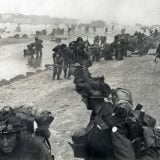
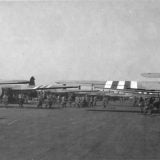
Sir Frank Whittle’s photo is printed the wrong way round – RAF wings on his right side, or is it my eyes!
Hi Richard. Thanks for pointing it out – we hadn’t taken that in but always thought there was something not quite right with the photo, somehow.
We have reported it to the IWM who published the photo in that form.